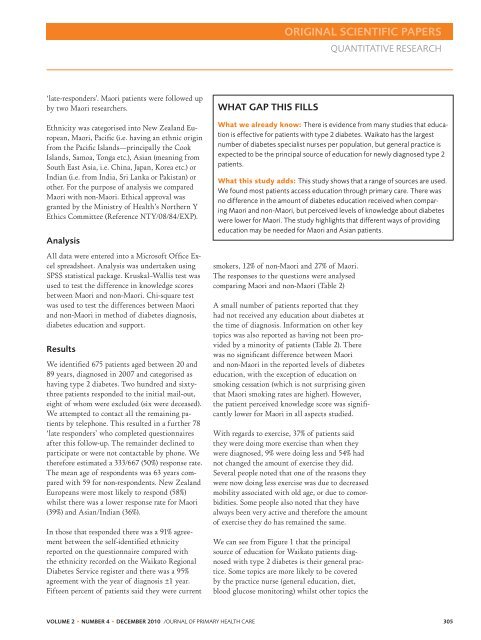The requirement to respect autonomy - The Royal New Zealand ...
The requirement to respect autonomy - The Royal New Zealand ...
The requirement to respect autonomy - The Royal New Zealand ...
- No tags were found...
You also want an ePaper? Increase the reach of your titles
YUMPU automatically turns print PDFs into web optimized ePapers that Google loves.
ORIGINAL SCIENTIFIC PAPErSquantitative research‘late-responders’. Maori patients were followed upby two Maori researchers.Ethnicity was categorised in<strong>to</strong> <strong>New</strong> <strong>Zealand</strong> European,Maori, Pacific (i.e. having an ethnic originfrom the Pacific Islands—principally the CookIslands, Samoa, Tonga etc.), Asian (meaning fromSouth East Asia, i.e. China, Japan, Korea etc.) orIndian (i.e. from India, Sri Lanka or Pakistan) orother. For the purpose of analysis we comparedMaori with non-Maori. Ethical approval wasgranted by the Ministry of Health’s Northern YEthics Committee (Reference NTY/08/84/EXP).AnalysisAll data were entered in<strong>to</strong> a Microsoft Office Excelspreadsheet. Analysis was undertaken usingSPSS statistical package. Kruskal–Wallis test wasused <strong>to</strong> test the difference in knowledge scoresbetween Maori and non-Maori. Chi-square testwas used <strong>to</strong> test the differences between Maoriand non-Maori in method of diabetes diagnosis,diabetes education and support.ResultsWe identified 675 patients aged between 20 and89 years, diagnosed in 2007 and categorised ashaving type 2 diabetes. Two hundred and sixtythreepatients responded <strong>to</strong> the initial mail-out,eight of whom were excluded (six were deceased).We attempted <strong>to</strong> contact all the remaining patientsby telephone. This resulted in a further 78‘late responders’ who completed questionnairesafter this follow-up. <strong>The</strong> remainder declined <strong>to</strong>participate or were not contactable by phone. Wetherefore estimated a 333/667 (50%) response rate.<strong>The</strong> mean age of respondents was 63 years comparedwith 59 for non-respondents. <strong>New</strong> <strong>Zealand</strong>Europeans were most likely <strong>to</strong> respond (58%)whilst there was a lower response rate for Maori(39%) and Asian/Indian (36%).In those that responded there was a 91% agreementbetween the self-identified ethnicityreported on the questionnaire compared withthe ethnicity recorded on the Waika<strong>to</strong> RegionalDiabetes Service register and there was a 95%agreement with the year of diagnosis ±1 year.Fifteen percent of patients said they were currentWHAT GAP THIS FILLSWhat we already know: <strong>The</strong>re is evidence from many studies that educationis effective for patients with type 2 diabetes. Waika<strong>to</strong> has the largestnumber of diabetes specialist nurses per population, but general practice isexpected <strong>to</strong> be the principal source of education for newly diagnosed type 2patients.What this study adds: This study shows that a range of sources are used.We found most patients access education through primary care. <strong>The</strong>re wasno difference in the amount of diabetes education received when comparingMaori and non-Maori, but perceived levels of knowledge about diabeteswere lower for Maori. <strong>The</strong> study highlights that different ways of providingeducation may be needed for Maori and Asian patients.smokers, 12% of non-Maori and 27% of Maori.<strong>The</strong> responses <strong>to</strong> the questions were analysedcomparing Maori and non-Maori (Table 2)A small number of patients reported that theyhad not received any education about diabetes atthe time of diagnosis. Information on other key<strong>to</strong>pics was also reported as having not been providedby a minority of patients (Table 2). <strong>The</strong>rewas no significant difference between Maoriand non-Maori in the reported levels of diabeteseducation, with the exception of education onsmoking cessation (which is not surprising giventhat Maori smoking rates are higher). However,the patient perceived knowledge score was significantlylower for Maori in all aspects studied.With regards <strong>to</strong> exercise, 37% of patients saidthey were doing more exercise than when theywere diagnosed, 9% were doing less and 54% hadnot changed the amount of exercise they did.Several people noted that one of the reasons theywere now doing less exercise was due <strong>to</strong> decreasedmobility associated with old age, or due <strong>to</strong> comorbidities.Some people also noted that they havealways been very active and therefore the amoun<strong>to</strong>f exercise they do has remained the same.We can see from Figure 1 that the principalsource of education for Waika<strong>to</strong> patients diagnosedwith type 2 diabetes is their general practice.Some <strong>to</strong>pics are more likely <strong>to</strong> be coveredby the practice nurse (general education, diet,blood glucose moni<strong>to</strong>ring) whilst other <strong>to</strong>pics theVOLUME 2 • NUMBER 4 • DECEMBER 2010 J OURNAL OF PRIMARY HEALTH CARE 305
















